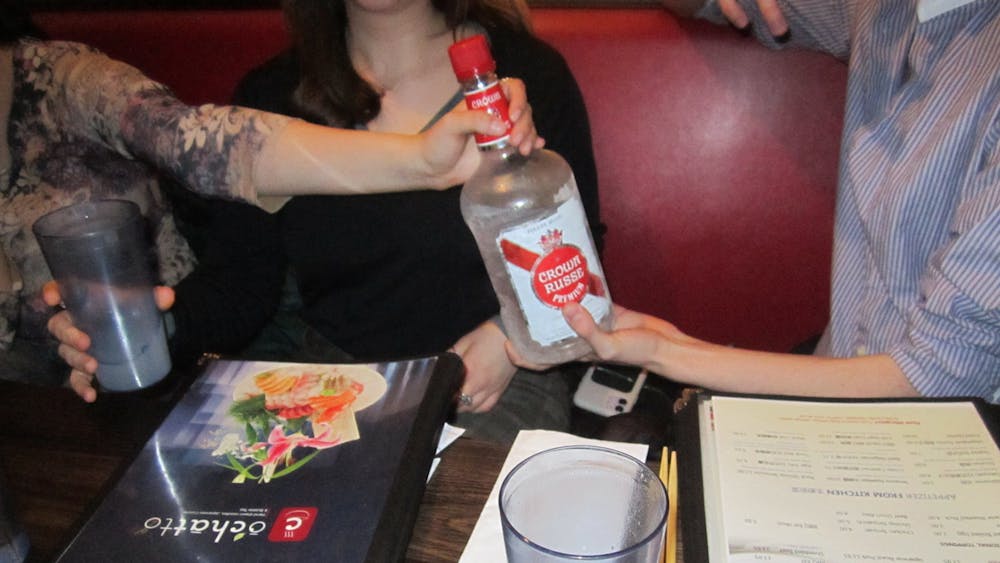100 years after prohibition, Philly’s BYO restaurants are modern-day speakeasies.
Rowdy dinners at “bring your own” establishments like Ken’s and Ochatto, cornerstones of Penn’s culture, originally emerged as loopholes to Pennsylvania’s notoriously strict liquor control laws. These laws were imposed in 1933, just days before the repeal of prohibition, and established a state monopoly over the sale of alcoholic beverages. Consequently, the one P.A. liquor store, Fine Wine and Good Spirits, is state owned. These laws also explain the scarcity of restaurant liquor licenses.
Only one license is available for every 3,000 residents of a county, and these certifications are bought and sold between restaurants, or auctioned off by the state, for upwards of $400,000. Even before large supermarket chains started snatching up, and driving up the price of the very few available liquor licenses, most P.A. restaurants couldn’t legally sell alcohol.
Enter the BYO. From the mountains of red tape surrounding Pennsylvania’s liquor control laws, degeneracy ensues.
In either a fatal oversight, or a stroke of genius, the state of Pennsylvania deemed it acceptable for patrons to bring their own alcohol into restaurants without liquor licenses. Many BYO establishments will provide corkscrews, glassware, and an occasional shameful look, to groups of any size bringing outside beverages (purchased legally or not) to their establishment.
Even if the proceeds from those drinks aren’t going to the restaurant itself, customers tend to spend more money on food when they are too drunk to remember what it tastes like. With the money pre-spent, everyone stuck to their seats, and the bottles already on the table, drinks at a BYO feel free. It would be against the rules, and not to mention a waste, to leave sober.
The prominence of BYOs at Penn reflects the influence of US alcohol regulation on youth culture. A century ago, prohibition-era speakeasies were ground–zero for mainstream jazz music, Italian-American cuisine, and shorter dresses for women. They were also the first night–clubs in the US that allowed men and women to mingle over alcohol, in stark contrast to pre–prohibition men–only salons. When the state constructs a hurdle to the consumption of alcohol, the people will surmount it. Having to think outside the box from the get–go seems to invite a level of creativity that leaves a broader cultural imprint. In hindsight, the past century of liquor regulation in the US has made liquor consumption more innovative, rather than scarce.
Penn’s social organizations have taken advantage of this. Tempered by the formalities of a sit–down dinner, BYOs have been revealed as a far more comfortable place to drink with a group than a club or a bar. After all, they are much more cost-effective, don’t ask you to be very aware of your surroundings or keep track of your coat, and guarantee that you will be sitting in the same spot for at least an hour and a half. In the way that the secrecy of a speakeasy provided the level of privacy that allowed for more promiscuous social encounters, BYOs are a uniquely convenient setting to get absolutely hammered with your friends.
The nature of regulating one of man’s first vices, alcohol, is somewhat ironic. On the one hand, P.A. laws make it clear that alcohol is something potentially dangerous that should not be widely available. On the other hand, these rules capitalize on the fact that our culture can’t help but gather around alcohol, to the extent that the state wants to be the only one to promote, and profit, off of its sale. These mixed messages have the effect of gathering the youth around the few places they can drink like moths around a lightbulb.
If you make the kids go underground to drink, they will, and, while they're at it, will experiment with music and fashion. If you don’t let them buy drinks at a restaurant, they’ll bring twice as much with them than they would have bought in the first place. At one point, these adaptations were a happenstance, yet the traditions and cultural icons that form around them, and as a result of them, begin to feel as old as time. This speaks to the administrative failures of the US government, but even more about the determination of young people to carve out a drinking culture despite, and perhaps due to, attempts by the government to reign it in. Those limitations, and the cultural strides we make to overcome them, turn out to be a blessing in disguise.







